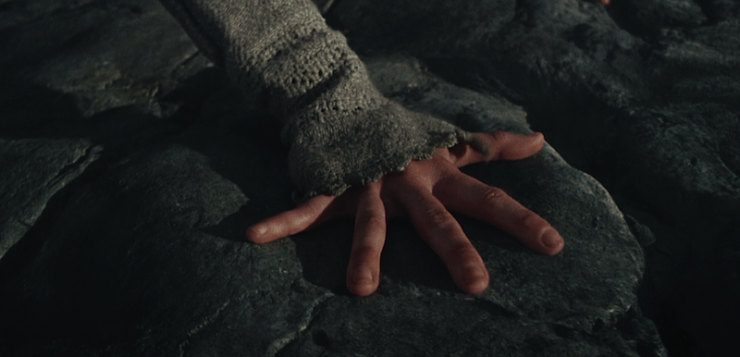While Star Wars is many things to many people, it is, at its heart, a story about a religious revival. If you look at the films chronologically, the stodgy Jedi Order collapses in spectacular fashion over the course of the Prequel Trilogy, leaving a few scattered Force believers looking for purpose in Rogue One, before a trio of Jedi Knights help restore balance in the Original Trilogy. But the Jedi Order Reboot also collapses spectacularly, and, in The Force Awakens and The Last Jedi, we’re back down to a couple of Force users who might be about to bring the religion back a second time.
I’m fascinated by the way the series uses parallels to real-life religious iconography to tell its story, especially how, in Rogue One and The Last Jedi, the filmmakers used some very specific references to create a richer and more inclusive galaxy far, far away.
In a 1999 article in Time, journalist and heroic journeyer Bill Moyers suggested that religion was central to Star Wars’ success, saying, “One explanation for the popularity of Star Wars when it appeared is that by the end of the 1970s, the hunger for spiritual experience was no longer being satisfied sufficiently by the traditional vessels of faith.” George Lucas, having rejected the idea that his films were “profoundly religious” said that he saw his films as “taking all the issues that religion represents and trying to distill them down into a more modern and easily accessible construct” and followed up by saying “I put the Force into the movie in order to try to awaken a certain kind of spirituality in young people—more a belief in God than a belief in any particular religious system. I wanted to make it so that young people would begin to ask questions about the mystery.”
I find this interesting, because the “modern” and “accessible” religion he created is, essentially, Taoism, which is pretty old even for a religion, and one which doesn’t really mention God—at least, not in any anthropomorphic, Western way. What we learn of the Force in the Original Trilogy is fairly vague. Luke is told that the Force is “an energy field created by all living things. It surrounds us and penetrates us; it binds the galaxy together.” He is told by his two masters, Obi-Wan and Yoda, to “use” the Force, and later that the Force is a “powerful ally.” The Force seems benign, but when Luke decides to go to Bespin to rescue his friends, he defends his choice by saying “I feel the Force,” and Yoda snaps that he can’t “control” it. Yoda also explicitly says that Luke will become “an agent of evil” if he bails on his training. So, what gives? Is the Force benevolent, or neutral? Will it push you into doing evil? And how is evil defined in this galaxy, anyway?
The Force and the Tao
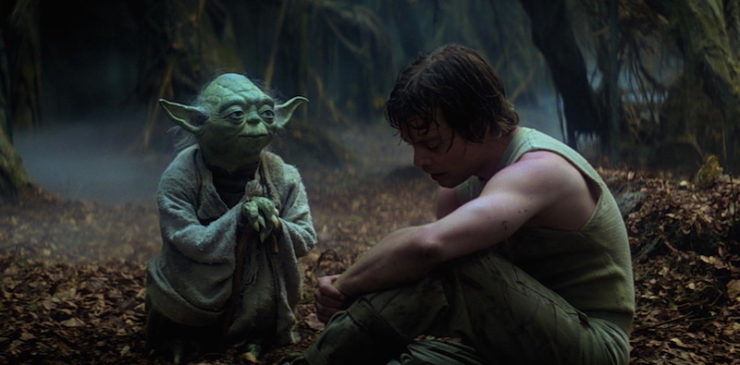
By building ambiguity into the largest religion in his universe, Lucas taps into a sort of streamlined version of Taoism. In the ancient Chinese religion, the Tao is a universal life force that flows around and within all things. Qi (sometimes written as “chi”) is your life force, the flow of your energy, and a “Qi Gong” is a person who has mastered their will in order to have a closer connection to the Tao. The goal in Taoism is “Te,” or acting in concert with the Tao, so you can achieve “Wu-wei,” or non-action—aligning your own will so closely with the Tao that you can act without truly acting. Remain still and passive in the face of life, to see how you can best align yourself with the flow of the universe. This is quite opposite to a typical Western view of life, and it also handily leaves aside ideas about sentience. If the Universe has a “will” or a “flow” does that imply a consciousness working toward a goal?
It’s also extremely similar to Yoda’s view of the Force—as he tells Luke, “You will know [the good from the bad] when you are calm, at peace. Passive. A Jedi uses the Force for knowledge and defense, never for attack.” But the path of the Jedi isn’t just a one-to-one analogue to Taoism. First, the Original Trilogy itself takes a hard turn into Buddhism at one point, and then, as the series has continued, the films have added new iconography and actively worked to disprove some of Yoda’s original teaching.
But Wait, Buddhism!
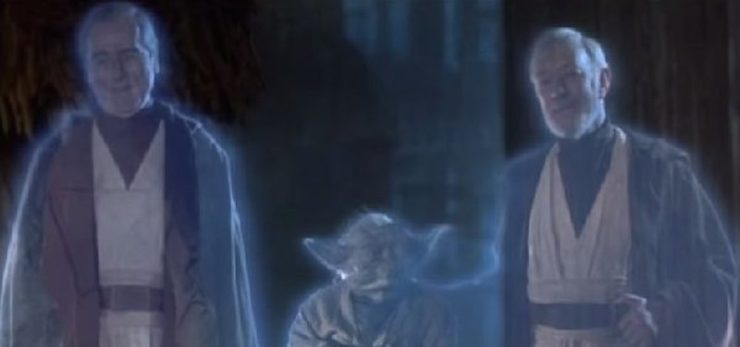
First, with regard to Buddhism: the obvious Taoist equivalent to a Force Ghost would be Xian, enlightened practitioners of Taoism who are either spiritually or physically immortal, and who often exhibit superhuman traits like flying. But I would argue that the Force Ghosts of Yoda and Obi-Wan act more like Boddhisatvas, and that their actions incorporate an aspect of Buddhism into the series to complement the Taoism. Boddhisatvas are Buddhists who, rather than achieving full Buddha-hood, dedicate themselves to the enlightenment of all beings—for example, the Boddhisatva Kṣitigarbha was said to have vowed to help less-enlightened human until all of them could achieve Nirvana, saying, “If I do not go to the hell to help the suffering beings there, who else will go? … if the hells are not empty I will not become a Buddha. Only when all living beings have been saved, will I attain Bodhi.” Yoda and Obi-Wan both seem to keep coming back from their Force One-ness to guide Luke on his journey, presumably so he can help all the beings suffering under the Empire. (They both learned this trick from Qui-Gon Jin, which, nice name, George.) When we do see Anakin’s Force Ghost in ROTJ, he’s appearing to give Luke peace of mind, so the young Jedi can move on with his life and pass on his teachings as Yoda instructed. While this isn’t an exact analogue, Yoda and Obi-Wan only seem to come back for the greater good of the universe, and their actions after physical death are purely spiritual, with none of the superhuman tricks that Xian sometimes perform.
The other shift is simply that there is an ongoing struggle in the films between attachment and non-attachment, and what I would call active versus passive compassion. Yoda and Obi-Wan feel bad for those suffering under the Empire. Obviously, Obi-Wan nearly collapses under the weight of Alderaan’s destruction. But from an old-school Jedi perspective all of these deaths are immaterial—the important thing is defeating Vader and bringing “balance.” But Luke figures something out that Obi-Wan, with his lifetime of baggage, or Yoda, with his commitment to passivity, never could have. As Emmet Asher-Perrin pointed out in this fantastic essay, compassion is Luke’s superpower. He’s not content to sit back and feel bad for others when he can, instead, run off to help them. Given his eventual success, I would argue that the Force is more benevolent than neutral, and that later influences the way he teaches Rey.
A Brief Word About the Prequel Trilogy
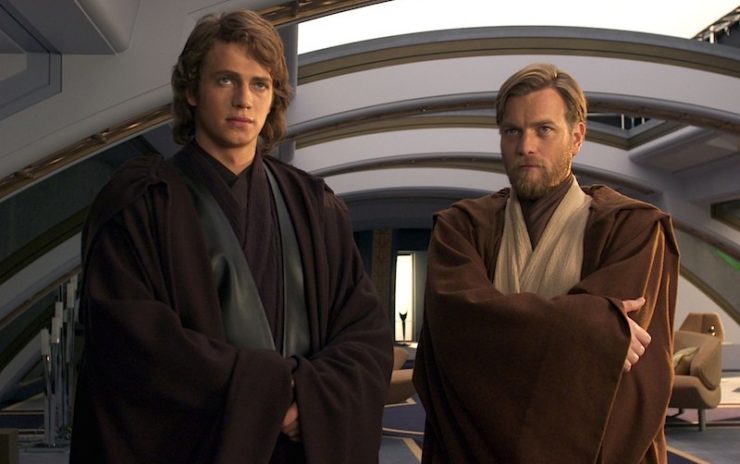
The prequels built the Jedi Order up into a rigid structure—Space Catholicism, or maybe High Church Anglicanism, where small counsels disseminate knowledge according to a strict hierarchy, children are indoctrinated from a young age, and the Jedi stalk about like Space Jesuits, all cool flowing robes and sardonic quips, venturing into distant reaches of the galaxy to act as living representations of the power of the Force.
Jedi Reboot
When the new films came out, one of my greatest hopes was that they would expand on the Jedi faith in-movie-universe, because as cool as some of the Legends Canon is, some of it also far-flung and unwieldy.
The Force Awakens was a bit more vague. Without a Jedi on hand to act as a spiritual leader, we had vague ideas about going on a quest for Luke, and a new generation that doesn’t understand how the Force works. The lightsaber battle between Kylo Ren and Rey seems to prove that not only is the Force alive and well, but that it’s also manifesting in particular people—Finn is able to wield Anakin Skywalker’s lightsaber, but Rey is able to summon it, and the Force manifests strongly enough in her that the saber sails right past Kylo Ren, despite his Skywalker bloodline.
Fine, but it didn’t really build on the old mythology, and it didn’t tell us anything we didn’t already know—since we knew nothing of Rey’s lineage at that point, she very well could have been a Skywalker, a Kenobi, or a Jinn.
The two most recent Star Wars movies, however, gave me everything I wanted and more.
The Holy City of NiJedha
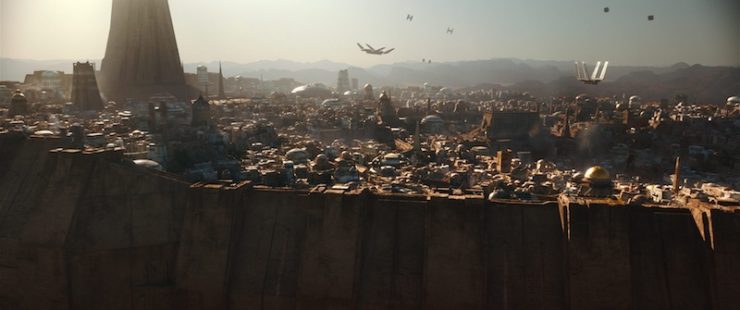
Rogue One did two things that I think are hugely important for Star Wars: first, it got out from under the Skywalkers. Jyn Erso is part of a completely different family, and there’s no indication that her ragtag crew have some giant destiny backing them up—they’re just the ones who were willing to take on a suicide mission to Scarif. It was such a weird sense of relief to watch the movie and know that we were in uncharted territory, and there weren’t any prophecies to be fulfilled or lineages to uphold. Galen Erso’s just a great engineer, and his daughter ended up working on both sides of the law to survive. No more, no less.
But the real depth and excitement for me came in the city of NiJedha. When we see the Holy City it’s something of a backwater—remote, dilapidated, and under tight control by the Empire. We can infer its past, however, because for the first time the films step away from a mélange of “Eastern” mysticism and go west. The City is tight and crowded. Tiny alleys and corridors zig and zag between sun-soaked, baked brick buildings. The Kyber Temple towers over the city, the sun glints off the golden Dome of Deliverance, and the Catacombs of Cadera hover just over the horizon.
We’re in Mecca and Jerusalem now, with Masada a short walk through the dunes.
Hear me out.
Mecca probably predates Islam as a pilgrimage site, but now about 2 million people a year undertake Hajj, the annual pilgrimage to the Al-Masjid Al-Ḥarām—the Sacred Mosque. Standing at the center of the Sacred Mosque is the Ka’aba, and embedded within the Ka’aba’s eastern corner is the Black Stone, an ancient relic that becomes the focus for tawaf, a ritual in which the pilgrim walks counterclockwise around the Stone seven times. Ideally the pilgrim kisses the stone, but because the Hajj can be dangerously crowded, it’s more customary now for people to point to it as they walk. There are many many traditions surrounding the Stone, including that it was embedded in the wall by Muhammed himself, that the Stone dates back to Adam and Eve, and that the Stone used to be white, but has darkened over the centuries from coming in contact with human sin. This is only one part of Hajj, which is a six-day-long event, with specific rituals for each day, but I’m focusing on it because it seems like such an obvious fit with the Kyber Temple.
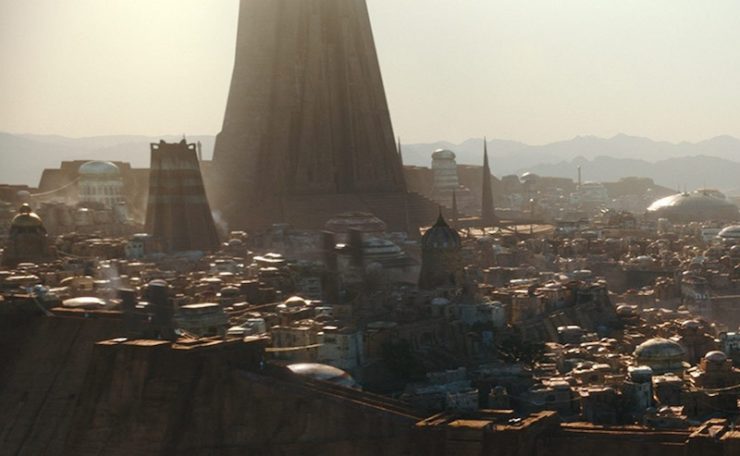
Beyond the alliterative effect of Ka’aba and Kyber, we have large, central structures that house crystals which have been imbued with meaning, and which attract a constant flow of pilgrims. While the Black Stone has many stories about its origin and meaning, Kyber crystals have two distinct functions – one is to power lightsabers, which are the elegant weapon of a civilized age, and the other is to fuel the Death Star, which obliterates everything in its path.
The Dome of Deliverance, featured in the front of the first panorama of NiJedha, recalls the Dome of the Rock:
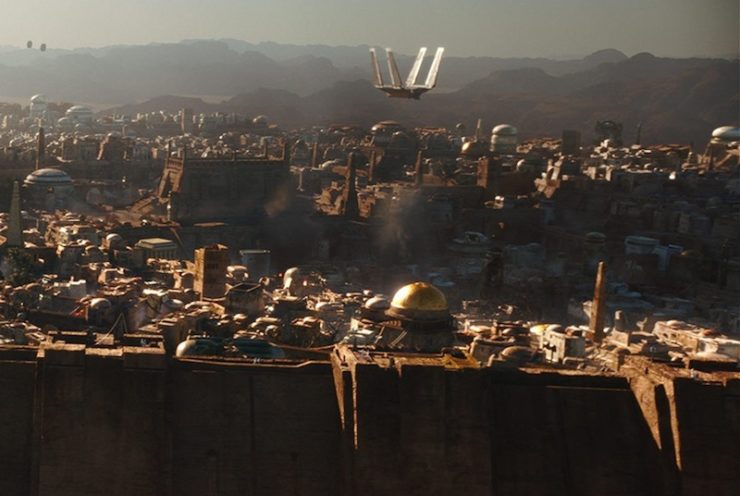
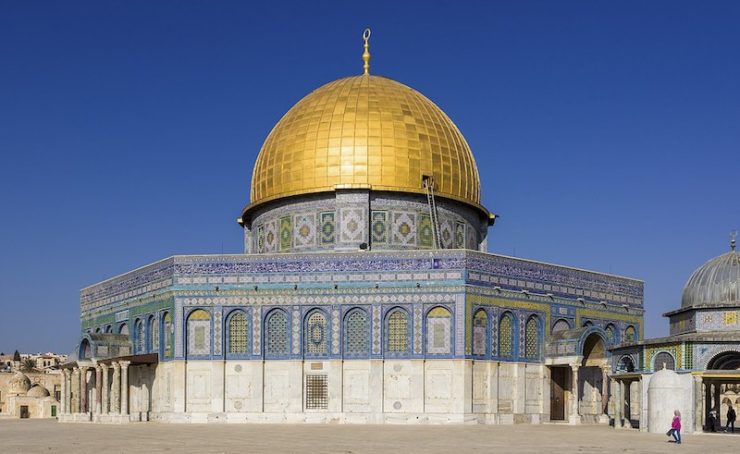
The Dome is a contentious site, important to each of the Big 3 monotheisms. [Deep breath] In Judaism, the Rock within the Dome is thought to be the place where God gathered the dust that was formed into Adam and Eve, and the site of Abraham’s near-sacrifice of Isaac. Historically it was the site of the Second Temple, until the Romans razed it during the First Jewish-Roman War in 70 C.E. The Romans built their own temple, Jupiter Capitolinus, on the site, which remained until 691 C.E. when the new Muslim ruling class replaced it with the Dome of the Rock. The Dome marks the site of Muhammed’s ascension to heaven during his Night Journey, or Isra Mi‘raj—a trip that saw Muhammed meeting with Abraham, Moses, Jesus, and other assorted prophets before being sent ahead to meet with God.
Once we get to Saw Gerrera’s hideout we find another visual reference point. By settling Gerrera’s headquarters in an ancient catacomb, the filmmakers recall several real-world religious motifs: early Christians, in hiding from an unforgiving Roman government; the Dead Sea Scroll writers, living an ascetic, communal life in a series of cliffside caves; and, most strongly for me, Masada.
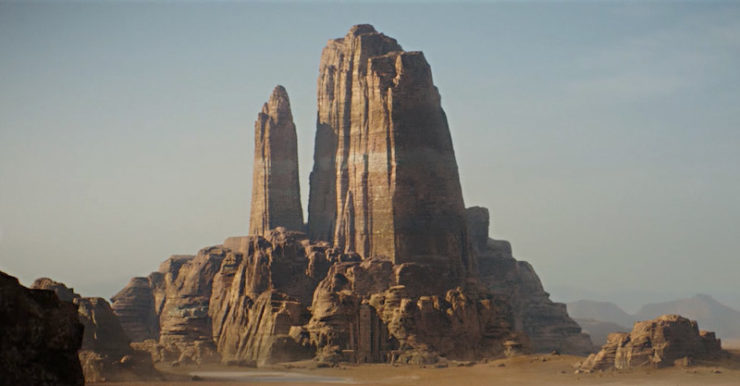
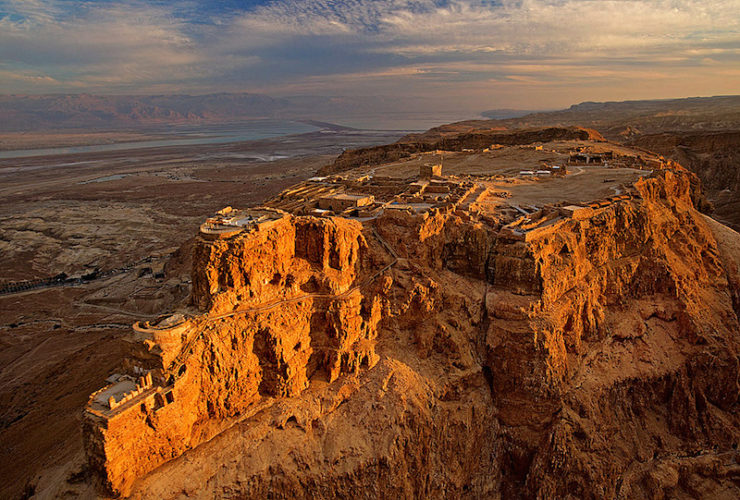
Masada was a fortress built atop a mesa. During the First Roman-Jewish War (66-73 CE) a group called the Zealots mounted a rebellion against Rome, in an attempt to regain Jewish control of Jerusalem. A splinter faction called the Sicarii carried out secret raids and assassinations during the course of the war, and for a time, Roman rule was broken, but then Rome sent more waves of troops in, crushed the rebellion, and destroyed the Second Temple. What was left of the Sicarii walled themselves into the fortress of Masada, and, according to some reports, committed mass suicide rather than surrender to the Romans.
By riffing on these real-life holy sites, Rogue One charges the Star Wars Universe with a sense of history and tradition that builds beautifully into A New Hope. Now when we rewatch the original Star Wars and we hear Han and Tarkin scoff at the Jedi religion, we have physical sites in mind—and we know that they were all destroyed.
Jedha was home to an ancient civilization, said to be the first to study the Force. There was speculation that it was the site of the First Jedi Temple, rather than Ahch-To, and it is home to several different temples and religious orders. It also hosts a near-constant stream of pilgrims, which is where Chirrut Imwe and Baze Malbus come in. As Guardians of the Whills, they traditionally protected the Kyber Temple, but, more importantly, they protected those who traveled to the Temple—of any faith. According to the additional canon books, that includes Jedi, Church of the Force, Brotherhood of the Beatific Countenance, Clan of the Toribota, Church of the Contained Crescent, or anyone else who entered the city with peaceful intentions.
What we have here is an idealized version of the Rome or Jerusalem of the 2nd Century CE, where dozens of types of paganism coexisted with Judaism, emergent Christianity, Buddhist monks, devotees of Mithra, Cynics, Stoics, and plenty of other believers. This vibrant, metropolitan, tolerant city, with all of its jostling faiths, is the first place ever attacked by the Death Star. The first time its own native minerals are used against it, and the kyber crystals, used to make lightsabers which at least ideally were intended as peacekeeping instruments, would now be used in a devastating war machine.
Which leads us into The Last Jedi, which incorporates a particular strain of Christian history to add to Star Wars’ theological Chex Mix.
Space Monks!
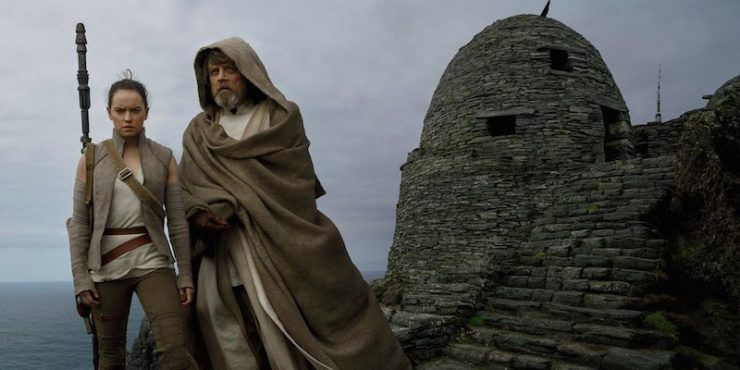
When Rey landed at Ahch-To, I was ecstatic to see that the films were incorporating an eerie Irish island in the SWU. But actually seeing how TLJ used Irish history and the traditions surrounding Celtic Christianity has made my heart grow multiple sizes.
Time for more history! Plenty of the stories that are tied up in “Celtic Christianity” are romanticized hyperbole. I mean this literally: the Romantics loved this idea of an unspoiled Celtic lands, lightly glazed in Christianity but still in touch with their pagan roots. The idea of Celtic Christianity is also popular in some corners of the New Age movement, where people can create a hybrid of Catholicism and paganism and feel that they’re tapping into an ancient unsullied tradition. (This is especially powerful if you’re a feminist, or queer, or trying to find a way to keep your faith in the face of, say, an abuse scandal.) Now in the midst of all the mist and pipes and peat-smoke fires, you’ll find a kernel of truth.
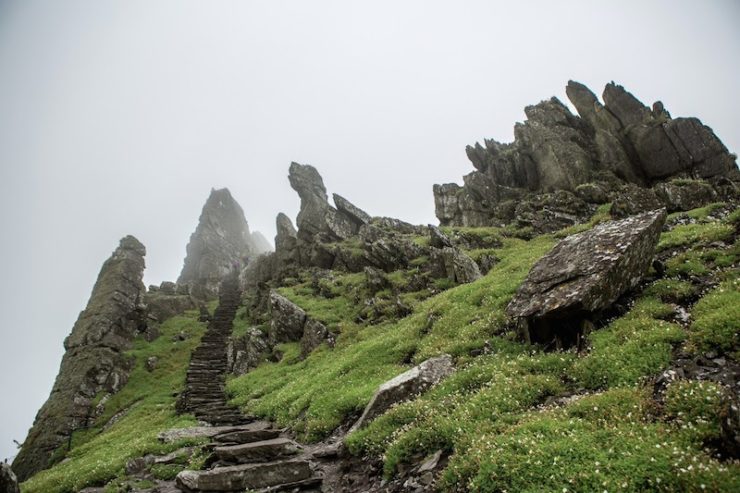
Irish monks did have a particular view of their religion, and in practicing it often adhered to an idea of austerity that was more extreme, and more personally-oriented, that the mainstream world of priests and bishops. Beyond just retiring to an abbey, many Irish and Scottish monks left the large islands entirely to build abbeys on the tiny, craggy islands that circle Western Ireland and northern Scotland. (Several famous monks did this to atone for murder, including Saints Columba and Patrick.) And rather than performing public penance, as was common in most of Europe, Celtic Christians practiced a private, inward-looking form of penance that became the root of the modern version of confession.
Luke fucked up. He really, seriously, fucked up. But rather than make up for it by recommitting to the resistance, or working publicly with his sister to fight the first order, he exiled himself to a monastery, living alone, denying himself comfort, and examining himself constantly for the root of his mistake. (In his training of Rey, Luke emphasizes this sense of interiority far more than Yoda did.) Right there we can see why the island of Skellig Michael and its ancient monastery would be resonant, but then the movie sticks to the theme and plays out a miniaturized sci-fi version of Irish monastic history.
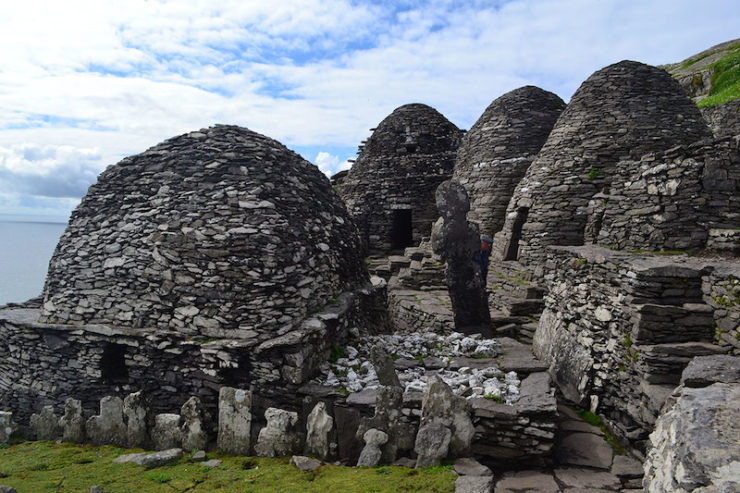
After the fall of Rome and Byzantium, monasteries became decentralized centers of learning, and the strongest of these were in Ireland and Scotland. The remoteness of the islands allowed monks to live quietly copying and illuminating manuscripts without the churning wars that affected continental Europe. Plus for whatever reason “exile for Christ” was extremely popular in Irish and Scottish Christianity. But this was just the beginning. The kicker (historical-religiously-speaking) was that starting in about 560 a monk named Columba traveled to Scotland and founded a monastery on the island Iona to do penance for murdering some people and starting a battle over who got to keep a psalter, and then the right of sanctuary was overridden a couple times, and tl;dr: Columba was almost excommunicated, but was allowed to go into exile instead. Hence, penitential monastery. About 50 years after Columba’s success in converting the Picts to Christianity, and founding several monasteries across Scotland, a monk named Columbanus led a small group across Europe, founding monasteries and inspiring Irish-influenced monastic cells across what is now France, Germany, Belgium, and Switzerland. This cemented a certain reputation Irish monks in particular had for carrying learning back across Europe in a time of unrest.
Meanwhile, back on those remote islands, Irish monks continued living in solitude, working on manuscripts, composing hymns, and hoarding books. There were no large towns in Ireland at that point, so monasteries were the largest cultural centers, and became targets for Viking raids during the 8th and 9th centuries. Vikings would attack, raid monasteries for metalwork, gold, and skalds, and then bolt back to Norway where they could display their treasure, and use it to prove their own power. Vikings working up and down the coast, even striking Skellig Michael, which is here:
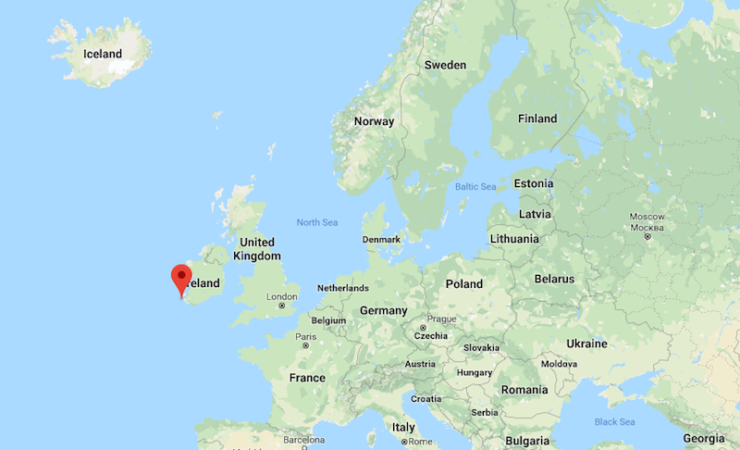
And it’s the filming location of Ahch-To, the planet that Luke has exiled himself to, and the site of the first Jedi Temple.
The Last Jedi director Rian Johnson worked with Skellig Michael—in the cutest example, the Porgs are literally CGI’d over the island’s real puffin population. But he also worked with the history of the island. The Caretakers are aquatic fish-bird hybrids, but they’re also dressed like Carmelite nuns. The all-female group cares for the Temple and structures, have lived on the islands for thousands of years, and merely “tolerate” Luke. They have their own rituals and devotion that have nothing to do with the rest of the people in the film, and have chosen to live in a type of exile, both from their natural home in the sea, and from other, non-Porg creatures.
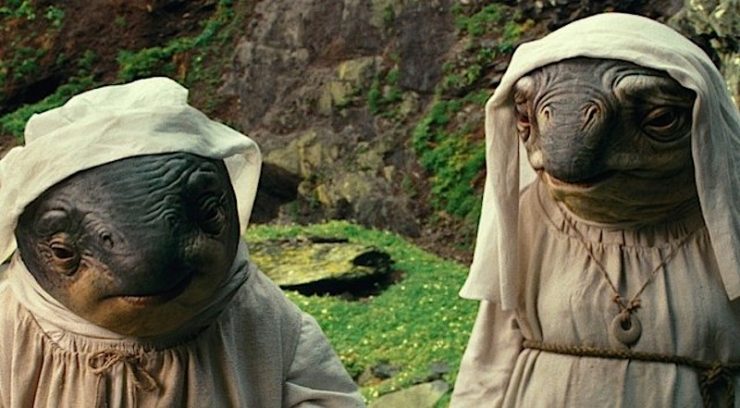
In a deleted scene, Rian Johnson incorporated the island’s history in an even more brutal way. According to Vulture, the scene started with Rey spotting a fire across the island, “and Luke telling her that it’s from a group of bandits that regularly raids and slaughters the Caretakers.” Rey rejects Luke’s demand that she submit to Jedi training by remaining passive, and instead sprints to the fire—to find the Caretakers, Porgs, Chewie, and Artoo dancing around a bonfire, because it was an elaborate test by Luke to make sure she’d put compassion and empathy before rules. Johnson ultimately cut the scene because it makes Luke look like a heartless jerk, but I desperately wish they’d kept it, because not only is the scene itself is a fascinating play on the island’s history—the Vikings did raid the real Caretakers, the Irish monks (with the raids seen as a test of faith, something to be endured)—but also because this moment would have underlined the evolution of the Jedi religion.
Luke’s superpower has always been empathy, and he rises to true heroism when he allows himself to act on that empathy, rather than following the Jedi rules of passivity and non-attachment. By actively testing Rey’s commitment to compassion, and hoping that she’ll snap out of the traditional Master/Apprentice relationship when people are in need, Luke shows that he’s pushing for a new understanding of the Force. One that is divorced from old hierarchies and free of the simplistic binary of Light and Dark that would have had him murder both his father and his nephew.
If we want to take this to its fullest extreme, the monastic Luke and Rey are acting against the wishes of the stodgy Jedi Order we saw in the prequels, much as Celtic Christianity (in the romantic view) stood as the liberal alternative to Roman Catholicism. Luke has rejected the hierarchy and rules of the Jedi Order, and tells his only remaining student that to believe the Force needs the Jedi to keep balance or create “light” in the galaxy is nothing more than arrogance. The Force is there, available to gothy Skywalker scions and broom-wielding stableboys alike. When Rey discovers the Whispering Tree and the Jedi Library, Luke tells her that none of it really matters compared to the Force. And when Yoda shows up for something that can be seen either as an epic troll, or a gift from a teacher to his old student, he burns the tree down and gives Luke no choice but to move on, and let go of his guilt and self-recrimination. I liked this moment, but I was also frustrated in the moment at the dismissal of a literary legacy—but more on that in a moment.
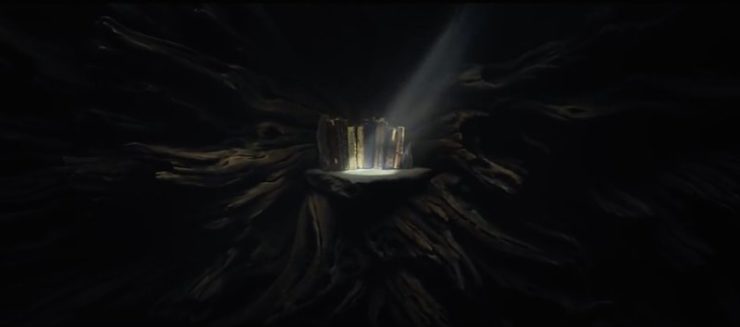
In the end the film unites three of the traditions it’s referenced. After Luke faces down the entire First Order with his laser sword, we learn that he hasn’t really been on Crait at all—he’s been projecting himself across the galaxy from Ahch-To. In this way he has both tapped back into the Force in true Taoist tradition, and stepped into the Boddhisatva role his old Masters occupied. He has sacrificed himself for the good of the many, and he’s done it without actually harming his old apprentice. Rather than succumbing to passivity, or spending any more time on private penance, he lets his compassion lead him back into an active part of the Star Wars drama—but on his own terms. When the film takes us back to Ahch-To, Luke is floating in full lotus position, looking every bit the Quasi-Buddhist Space Monk—he has allowed himself to be part of the flow of the universe again, and that Rey, without even realizing it, has effected the same redemption that Luke achieved for his father Anakin.
The end of the film reveals that Rey has snatched the Jedi writings and taken them with her, somewhat tempering the idea that she should just go with her gut. She’ll have a sense of Jedi history to balance her innate Force sensitivity, and, if need be, she’ll have the written history of the Jedi to draw upon. Rey is now the last monk, working her way through the galaxy, with a few friends and the nearly-lost teachings of an ancient order—Columbanus trekking through Europe with a handful of monks and copies of ancient teachings. But there’s a key difference. She’s not a Skywalker, or a Kenobi, or a Jin. She’s Nothing, Daughter of Nobody. She is the bridge between the aspirations and ideals so meticulously copied and preserved in the Jedi books, and the simple Force sensitivity of the stable boy with his broom. She is the one who can bring the true meaning of the Force to the people.
Leah Schnelbach doesn’t care if the Jedi writings aren’t page-turners, Yoda—she wants to read ’em anyway. Come discuss Jedi theology with her on Twitter!










